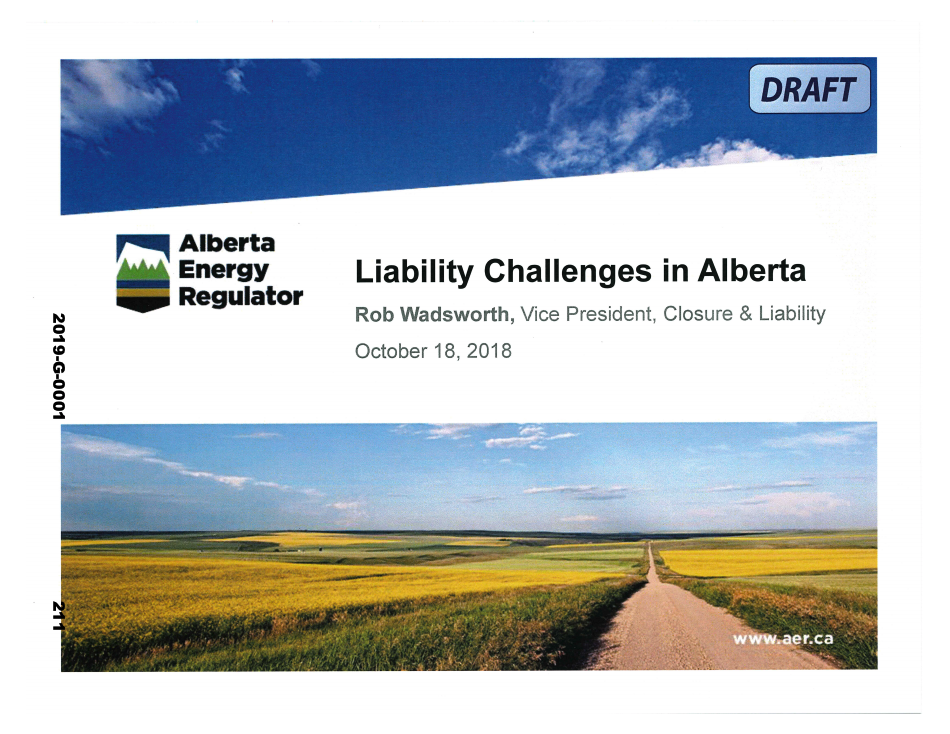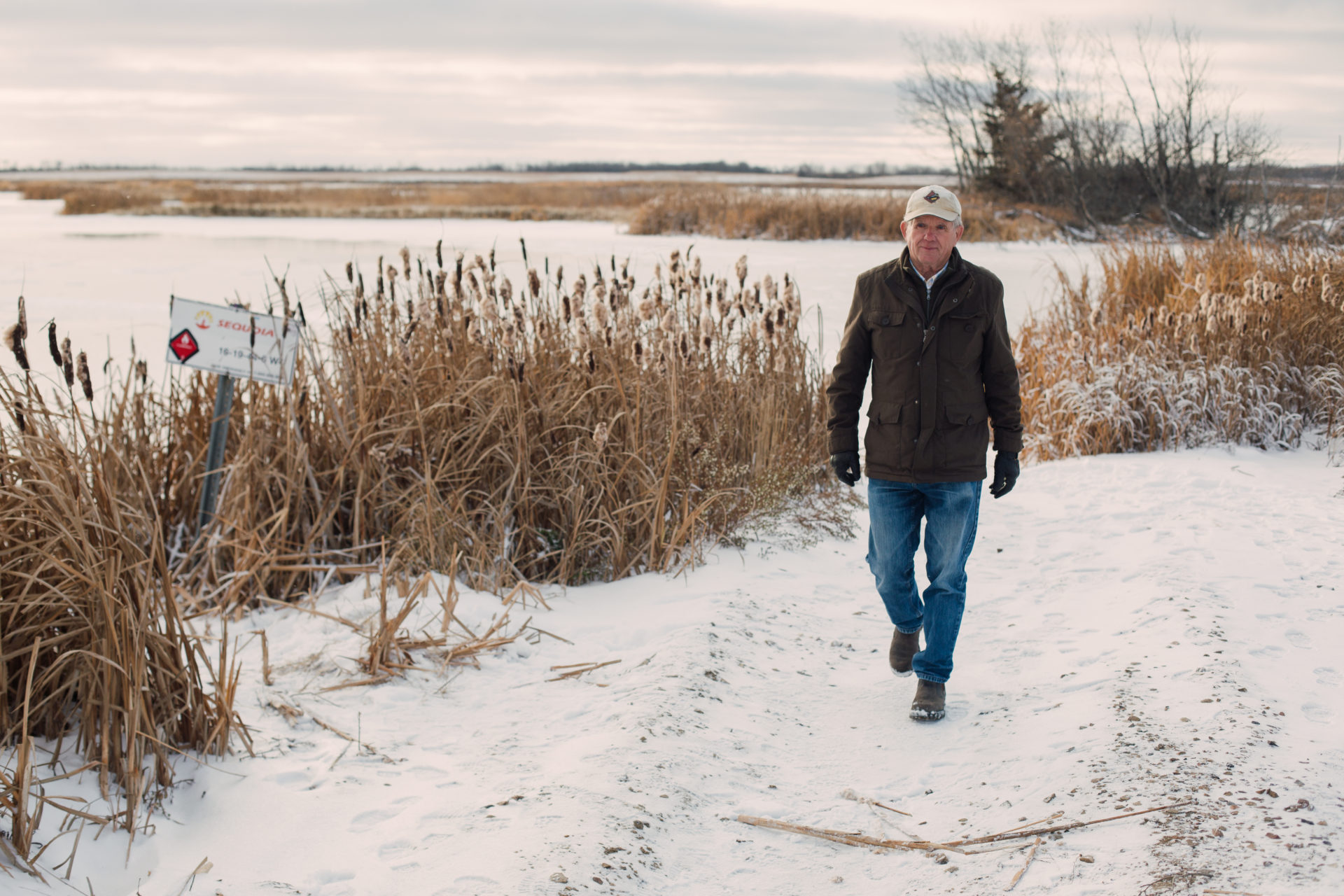
In a Nova Scotia research lab, the last hope for an ancient fish species
Racing against time, dwindling habitat and warming waters, scientists are trying to give this little-known...
A new presentation obtained by The Narwhal shows that senior staff at the Alberta Energy Regulator are projecting the number of inactive wells in the province could double in the next decade if there isn’t any change in policy.
In recent years, the backlog of wells in Alberta that are no longer active, but not yet cleaned up, has been steadily increasing. Right now, there are roughly 90,000 inactive wells in the province.
The presentation obtained by The Narwhal reveals senior staff at the Alberta Energy Regulator are privately projecting that number could double to 180,000 by 2030.
The cost of cleaning up wells is huge. Today, the Alberta Liabilities Disclosure Project
, a coalition of landowners, oil and gas companies, academics and civil society groups, dubbed the problem of the province’s wells “a massive ticking time bomb.”
Inactive wells have never been plugged or sealed, are unlikely to ever be productive again, and can languish on the landscape for years — or decades. As The Globe and Mail reported last fall, the oldest inactive well in Alberta dates back to 1918.
The presentation — obtained by The Narwhal in a freedom of information request — shows that in 1999 there were approximately 30,000 inactive wells in the province, a third of the number that exist today.
In addition to the 90,000 inactive wells today, another 77,000
are what’s known as abandoned — the industry term for safely plugged — but they too are not yet reclaimed. Reclamation involves restoring the well site’s soil and vegetation. There are hundreds of thousands of wells in the province.
The rapid increase in inactive wells has implications for the estimated tens of billions in liabilities industry faces for well cleanup costs. But these costs are not borne by industry alone.
Not only is there a burgeoning number of orphan wells in recent years, but taxpayers can end up picking up the tab for rent owed to landowners. The Narwhal reported in February that the rent payments government has made to landowners on behalf of delinquent companies is up 840 per cent since 2010.
“It’s a huge issue,” said Thomas Schneider, an associate professor of accounting at Ryerson University who studies environmental liabilities.
“It’s a pretty sad legacy to leave behind.”
The presentation, entitled “Liability Challenges in Alberta,” was made by the regulator’s vice president of closure and viability, Robert Wadsworth, in a meeting with representatives from the Canadian Association of Petroleum Producers (CAPP) in October.
The presentation was obtained after The Narwhal asked the Alberta Energy Regulator to release a year’s worth of emails and lobbying records with the Canadian Association of Petroleum Producers. The request entailed such a “large volume of records” that the regulator charged The Narwhal $643.95 to access the documents. Our readers quickly stepped up to the plate and donated the money to pay the fee.
“We have a problem,” the presentation began.
Wadsworth presented data on the past 20 years of well closure in Alberta. While the number of wells abandoned annually — “abandoned” is the industry term for sealing or plugging a well, the first step in reclaiming a site — has remained relatively constant, the number of inactive wells has increased at a rate of six per cent per year.

The title page of a 2018 Alberta Energy Regulator presentation released to The Narwhal via Freedom of Information legislation.
“Industry needs to increase closure activities,” the presentation states.
The presentation also said that a “manageable inactive inventory” would be about 20,000 wells — less than a quarter of the current inventory.
The Narwhal asked the Alberta Energy Regulator by email if Wadsworth’s projection of a doubling of the inventory of inactive wells by 2030 is a situation the organization is anticipating.
A spokesperson did not specifically answer the question, writing instead by email that, “the liability issue has been identified as a corporate priority,” adding, “we are working towards finding solutions.”
In his presentation, Wadsworth indicates that “quotas and timelines” could prevent the explosion in inventory projected in the next ten years.
Alberta’s well liability problem has become an issue of note in the provincial election, with the NDP vowing to “implement clear timelines for when companies need to clean up their abandoned oil and gas wells and require them to justify delays in reclaiming sites.”
The United Conservative Party (UCP) platform makes no such promise, indicating instead it would ask the federal government for tax incentives for reclamation, and “speed up approvals” of new wells.
An editorial in the Edmonton Journal last week declared that the issue of oil and gas liabilities “may be the biggest single issue that has ever faced this province.”
Companies may leave wells to sit inactive because it’s expensive to clean them up.
The Alberta Energy Regulator estimates it can cost $12,800 to $134,177 to plug a well, and $16,500 to $42,155 to reclaim the site.
As The Narwhal reported last fall, a researcher at the University of Calgary found that actual reclamation costs can easily be 60 per cent higher than the regulator’s estimates. Others have said the numbers may be far higher.
The presentation obtained by The Narwhal indicates that if current conditions continued, it would take 126 years to plug all wells in the province — and this doesn’t include reclamation of the landscape.
Nor does it take into account what could happen to struggling energy companies if oil prices don’t rebound the way Albertans hope they will.
The Alberta Liabilities Disclosure Project, using data from the regulator’s public estimates, estimates the actual cost of cleanup of each well in the province is between $40 and $70 billion.
The result, according to a press release, is a liability “2 to 3.5 times higher than the $18.5 billion [the regulator has] told Albertans.”
According to the group, $200 million is currently being held as a deposit — less than 0.3 per cent of the group’s estimated total cost of clean up.
“Albertans are at risk of being on the hook for an oil well cleanup bill $22 to $51 billion more than the publicly reported estimates,” the Alberta Liability Disclosure project said in a statement.
“That’s a massive problem.”
The Alberta Energy Regulator did not respond to request for comments on these new figures by press time.
Currently, a company is issued a reclamation certificate from the Alberta Energy Regulator after a wellsite has been fully reclaimed — though questions have been raised about the quality of the work being approved.
Wadsworth’s presentation suggests the regulator might consider issuing reclamation certificates before all reclamation work is completed through the use of “progressive and partial” certificates.
When asked for clarification, a regulator spokesperson said progressive certificates would mark “stages or major milestones of reclamation activity,” while partial certificates would be used when only a portion of an active site has been reclaimed.
It seems a company may be able to receive some sort of credit from the regulator before finalizing full cleanup of a site.
Both new types of certificates are “are still being assessed and reviewed,” according to the spokesperson.
When The Narwhal asked if a partial reclamation certificate would mean a company may be off the hook for making rental payments to landowners, the regulator declined to answer.

Mike Smith, retired oil and gas well reclamation inspector, at a flooded oil lease site in Wainwright, Alta. This site has been suspended, according to the regulator. Smith lives nearby and drives by the site occasionally, to see if any reclamation work is being done. It isn’t. He’s seen plenty of contamination issues over his career. If no one checks, he worries about the long term recovery of sites. “Those problems are still there,” he says. Photo: Amber Bracken / The Narwhal
The regulator has long been criticized for allowing financially precarious companies to obtain licenses for wells associated with large environmental liabilities. The Orphan Well Association lists 2,000 wells in the province that have yet to be ‘abandoned,’ an industry term for properly sealed, and whose owners are now bankrupt.
The presentation suggests that a “corporate health tool” could replace the regulator’s current system for rating liabilities which is used to determine if a new well should be approved.
In the presentation, the tool is described as an automated system used to weigh a company’s ratio of inactive wells with inventory, production and financial health among other factors. In its election platform, the NDP indicated plans to implement a corporate health tool of this kind. (See The Narwhal’s comparison of NDP and UCP platforms when it comes to oil and gas wells here.)
A spokesperson with the regulator told The Narwhal, “we are currently refining a corporate assessment tool to assess risk using financial, behavioural, and inventory risk factors.”
The spokesperson noted that the regulator already has “more discretion to reject applications” than in previous years and that companies are now required to disclose audited financial statements or insolvency proceedings.
But Schneider, an expert in environmental liabilities, is concerned that not even a corporate health tool can predict whether a company will be able to pay for clean up in the future. He also worries that this kind of assessment can favour large companies.
“They look healthy” at first, he said, “then everything goes south.”
Without a deposit on hand, he added, there’s no guarantee that clean-up costs will be covered.
As for whether the province is going to take any serious steps towards mitigating the growth of inactive wells, Schneider isn’t sure.
“It’s a question of political will,” he said. “The only solution is starting to do the actual decommissioning.”
“We need to start getting serious security put to the side,” Schneider says, noting the current system “leaves too much room for politics and regulatory capture.”
There are concerns that a rush to reduce liabilities on paper could lead to lax regulations around certification. A recent investigation by The Narwhal found that the regulator approves 97 per cent of reclamation certificates without sending an auditor to the site, despite having previously assured the public 15 per cent of sites would be visited.
Then there are concerns about what happens to the hundreds of thousands of wells puncturing Alberta’s landscape if the industry becomes less profitable.
“It’s an industry that’s not going to last forever — whatever you say the horizon is,” Shneider told The Narwhal.
The question remains: who’s going to end up with the bill?
In Wadsworth’s presentation, he highlighted that “growing liabilities” are a “shared liability problem” — shared, he noted, by industry, the regulator, government and taxpayers.
Wadsworth pointed to “industry retain[ing] the liability” as a “strategic goal” in the coming years. But no one knows for sure if this is really in the cards.
“The oil and gas industry is legally obligated to fund the cleanup of its environmental liabilities,” Greg Rogers, an environmental risk and liability consultant and member of the Alberta Liability Disclosure Project, said in a press release.
“But the industry isn’t setting aside anywhere near enough money to do it which means the public will be left on the hook for the costs.”
“If it ends up in the hands of Alberta to pay for it, it’s a huge liability,” Schneider said.
Wadsworth AER Presentation Liability Challenges in Alberta by The Narwhal on Scribd
Get the inside scoop on The Narwhal’s environment and climate reporting by signing up for our free newsletter. On March 17, federal Conservative Leader Pierre Poilievre...
Continue reading
Racing against time, dwindling habitat and warming waters, scientists are trying to give this little-known...

From investigative reporting to stunning photography, we’ve been recognized with four 2024 CAJ Awards nods...

The Narwhal is expanding its reach on video platforms like YouTube and TikTok. First up?...
